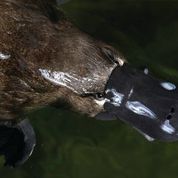
The genomes of egg-laying monotreme mammals, platypus and echidna, have been published in the prestigious journal Nature, providing a valuable public resource for research in mammalian biology and evolution, with applications for their conservation and health.
Monotremes display a unique mix of mammalian and reptilian features and form the most distantly related, and least understood, group of living mammals. Their genetic blueprint provides fundamental insights into their unique biology and into the evolution of all mammals.
"The platypus and echidna are the only egg-laying mammals, and so provide the key to understanding the change in reproductive strategy from egg-laying to the production of live young in all other mammals," Professor Marilyn Renfree from the University of Melbourne's School of BioSciences said.
"During their short in egg incubation, they have kept one of the three major egg proteins that is used to make the yolk in chickens, but after hatching both platypus and echidna have a complex milk like other mammals to support their young during their long lactation."
The research was the result of an international collaboration involving Australian scientists from the Universities of Melbourne, Adelaide, Sydney, LaTrobe University, as well as researchers from China, Japan, USA and Denmark.
The 40 researchers brought together expertise in bioinformatics, cytogenetics, developmental and molecular biology to produce and analyse the first ever echidna genome and a greatly improved, high quality platypus genome sequence.
University of Adelaide Professor Frank Grutzner, who co-led the study, said the findings were significant.
"More than 15 years ago we discovered that monotremes have different sex chromosomes to all other mammals," Professor Grutzner said.
"This finding revolutionised our understanding of mammalian sex chromosome evolution but also raised fundamental new questions. With the new genomes we can now tackle important questions about how sex chromosomes control monotreme sexual development and reproduction, and how they evolved."
Co-first author of the study, University of Adelaide Dr Linda Shearwin-Whyatt, said the system for safe removal of the oxygen carrier, haemoglobin from blood was thought to be common to all mammals.
"We were surprised when we discovered the system was missing from monotremes, implying that it arose quite recently in the ancestor of all other mammals," she said.
In contrast, University of Melbourne Dr Fenelon points out that monotremes have lost several key tooth genes and their adult teeth.
LaTrobe University's Professor Jenny Graves said the egg-laying monotremes, unique to Australia, help to answer some of our deepest questions of mammal evolution.
"We last shared a common ancestor with the platypus and echidna about 180 million years ago, so comparing the monotreme and human genomes can tell us about our common ancestor," Professor Graves said.
Knowledge of monotreme reproduction is also relevant for conservation and captive breeding programs. Researchers are excited that the new genome sequences also provide a roadmap for genetic management of threatened echidna populations and exciting new leads for drug development via the discovery of novel peptides in platypus venom.
Professor Renfree said the new understanding would help conserve these iconic and unique Australian mammals.






